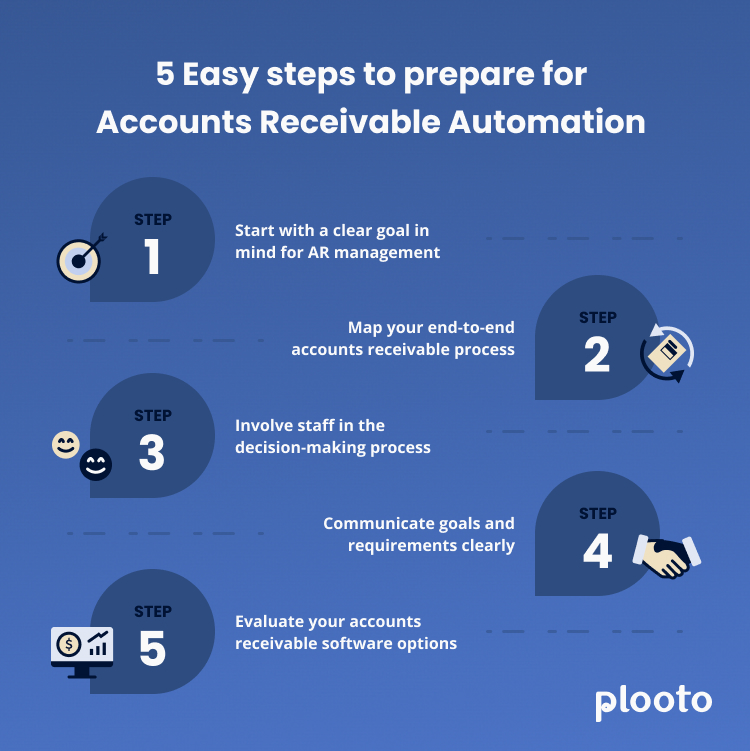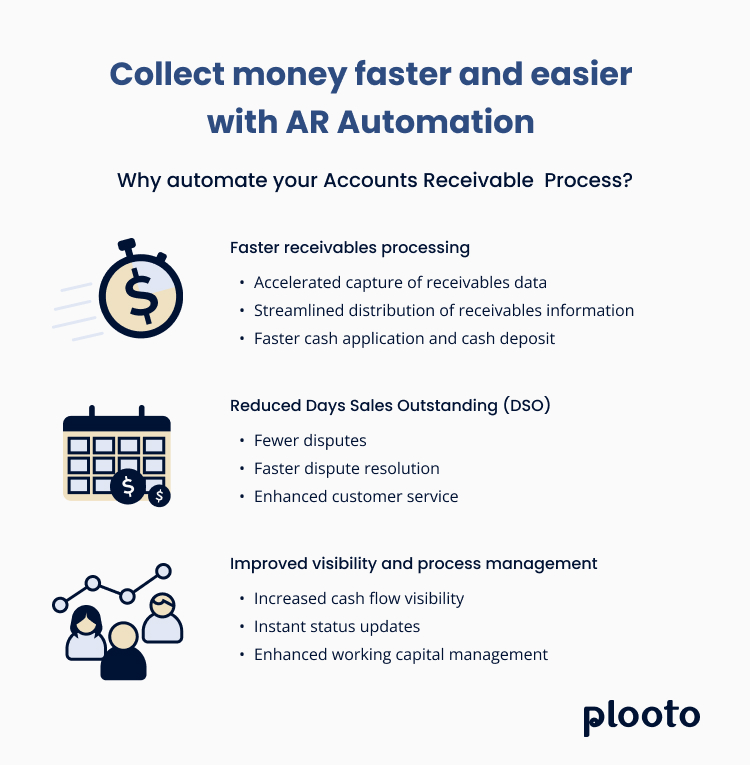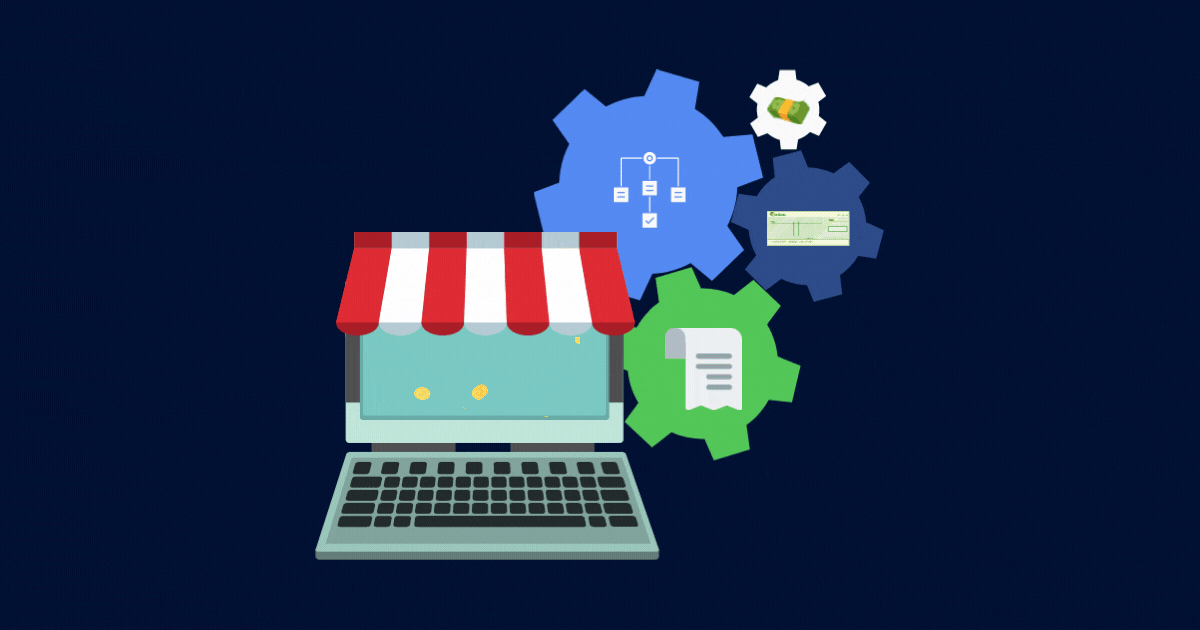
Accounts receivable: It’s simple until it’s not.
According to a PWC report, finance teams spend 30% of their time collecting data and reconciling it between systems. This is likely because of two things:
- Accounts receivables and accounts payables have increased in volume to the point where these finance teams must spend more time on data entry and reconciliation.
- These finance teams are using obsolete double-entry accounting methods to keep track of their accounts receivables and accounts payable.
While accounts receivable is a simple process in principle, it becomes complicated when you have a lot of customers or clients. While this is the kind of problem you want for your business, it's also a signal that processes need to evolve so your finance team isn't weighed down by manual administrative tasks.
This is where affordable, easy-to-use software can help. Keep reading to learn everything you need to know about accounts receivable automation software before investing in it, including how it works, what to look for when comparing platforms, and the outcomes you can expect if you decide to adopt it.
Sign up for a Free Trial today.
SHORTCUTS
- What is an accounts receivable system?
- What is accounts receivable automation software?
- Why should I consider switching to accounts receivable automation for my business?
- How to prepare for accounts receivable automation
- Overview of accounts receivable automation software
- How does automation of accounts receivable processes lead to improved efficiency?
- What solutions exist for accounts receivable automation and how can these can improve cash flow?
- Components of accounts receivable automation software
- Benefits of accounts receivable automation software
- 5 easy steps to prepare for accounts receivable automation
- Key features to consider when choosing an accounts receivable automation solution
- Tips to streamline your accounts receivable automation
What is an accounts receivable system?
An accounts receivable system tracks the amount of money owed to a business. Accounts receivable systems use invoicing with set payment terms to create a payment schedule of expected revenue. Accounts receivables are considered assets on your balance sheet because it’s cash flow you can expect to see in the near future.
What is accounts receivable automation software?
Accounts receivable (AR) automation software is any payment software, usually integrated with accounting software, that allows businesses to accept electronic payments from clients.
Why should I consider switching to accounts receivable automation for my business?
Accounting solutions can drastically optimize how finances are managed - you should consider switching to accounts receivable automation to improve and avoid outstanding receivables. Accounts receivable automation makes it easier to stay on top of payments by reminding clients to pay you and offering an easy way to pay, which reduces bad debt and manual reminders.
How to prepare for accounts receivable automation
When was the last time you questioned why your process is the way it is? To automate any workflow, you need to start by deconstructing it. Here's how you can start to prepare to automate your accounts receivables, step by step:
1. Analyze your current accounts receivable process for bottlenecks.
This step is especially important for businesses with a lot of outstanding payments. Start by writing down your entire accounts receivable process and answering some basic questions: How long does it take me to get paid on average? When late payments happen, why do they happen? Which part of the payment process can I make easier for my customers? How long are my typical payment terms? Do I need to shorten them to improve cash flow?
2. Choose which parts of your accounts receivable processes are ripe for automation.
Every business is different, and you may not need to automate every step of your accounts receivable process. On the one hand, you may be getting paid on time but wasting a lot of time on manual data entry. On the other hand, you may be trying to figure out how to improve your cash flow in the short term, and you're not worried about tackling manual data entry just yet. It's worth looking at how automated accounts receivable software could save you time and money.
3. Choose a payment automation platform.
Payment automation software will allow you to start accepting different online payment options. This includes payments via credit card, EFT payments, ACH payments, and e-transfers, etc. Bonus if you can make it easy for customers to send payments in multiple currencies.
4. Integrate your accounts receivable automation platform with your accounting platform.
Eliminate manual data entry with auto-reconciliation. Your accounts receivable software should “talk to” your accounting software through an API, so that your financial records are updated automatically when you receive a payment. This automation is one of the most important time-saving measures in accounts receivable software.
5. Set up a pre-authorized debit (PAD) agreement for recurring payments.
If some of your customers are paying you the same amount on a monthly basis, instead of sending them recurring invoices, see if they would be amenable to automating them with a PAD agreement.
A PAD agreement may be set up within an accounts receivable software that allows you to track and receive payments online. When the customer signs the agreement, payments will be taken from their bank account automatically according to your payment terms. This is a big step in reducing bad debt from outstanding payments, as well as getting faster payments.
6. Send your customers a clear invoice with automated follow ups.
Now that you're set up with automation software, send an electronic invoice that includes:
-
Accounts payable contact information
-
Your company's basic information
-
Their company's basic information
-
Balance due, including taxes
-
Payment terms (ex. Net 30)
-
Invoice date
-
Product or service line items
The most important part of this process is writing your friendly reminder, which will go out automatically if payment is late. Accounts receivable software allows you to choose when to send the reminder, whether payment is late by one day, three days, one week, etc. The system should be sending reminders before the due date. If the reminders are only sent when payment is overdue, it's too late.
Overview of accounts receivable automation software
Accounts receivable automation software allows you to receive electronic payments to vendors. But there's more to it than that.
Accounts receivable software:
-
Maximizes cloud computing by uniting your payments, accounting, and banking processes in one place.
-
Improves cash flow visibility with real-time reconciliation between financial reports.
-
Makes it easier to get paid by offering customers a variety of ways to pay online instead of restricting their payment options.
-
Eliminates the need to chase down overdue payments with endless email follow-ups.
-
Automates monthly recurring invoices through PAD agreements, which reduce outstanding payments and bad debt.
How does automation of accounts receivable processes lead to improved efficiency?
Accounts receivable software improves efficiency by reducing invoicing errors, which ultimately saves money in labor costs.
In 2010, when only 25% of invoices were sent electronically, research from Sterling Commerce indicated that every paper invoice error cost companies $53.50 to correct. We've come a long way in 12 years with payment processing tools, and automation has largely eliminated extraneous costs like these with trackable electronic invoicing.
What solutions exist for accounts receivable automation and how can these can improve cash flow?
Accounts receivable solutions are a combination of accounting software and payment software, which fit together as integrations that share data on the status of accounts receivables.
As a first step, payment automation makes it easy for customers to pay you and simplifies the invoice tracking process, with reminders that go out automatically. The next step in the process is to feed payment information into your accounting software, which opens up true visibility into cash flow.
For example, Plooto and Quickbooks or Plooto and Xero work together to reconcile data without manual data entry, which translates to real-time cash flow statements.
Components of accounts receivable software
If you could hold accounts receivable software in your hands, what would you be holding on to? Here are the main components that drive functionality:
Optical Character Recognition (OCR) data capture for check processing
If you're paid by check, OCR is technology that can read information on a paper check and convert that information into digital text. When you convert a printed document into something that can be read by a machine, data entry is eliminated. This way you can still process paper checks for customers who insist on using them, but the information is still centralized for auto-reconciliation with your accounting software.
Payment network
A payment network is an association of member banks that handle secure transactions between companies and vendors. The Automated Clearing House, for example, facilitates the moving of money from one bank account to another via direct deposits and direct payments. This is important for verifying payments coming in, to ensure compliance and security.
Cloud storage for remote sharing of information
When all payment and accounting information is stored in the cloud, location no longer matters when sharing information. Especially relevant for remote workers, real-time financial reporting that lives in the cloud with controlled permissions transforms “report making” into “report sharing” without much of a fuss.
Accounting software integration
Payment software should talk to your accounting software through an API. This is what makes it possible for accounts payable departments to eliminate the data entry that comes with double-entry accounting. Instead, with a software integration, they can sync their financial reporting in real-time, so numbers are accurate on multiple platforms.
Benefits of accounts receivable automation software
When you invest in accounts receivable management software, you'll see clear “before” and “after” scenarios. But what do those scenarios really look like? Here are some of the most common benefits teams see when they go from manual accounts receivable processes to automate their processes:
5 easy steps to prepare for accounts receivable automation
While the basics of accounts receivable follow some consistent steps, every department has different needs. You may be operating within a small finance team or managing a large team who all need access to different kinds of information. Maybe you are looking specifically for software for small businesses. Here's how to assess your needs before you invest in an accounts receivable software:
1. Map your end-to-end accounts receivable process.
How often do we stop to think about whether or not our standard processes are working for us? Now is as good a time as any to write down your accounts receivable process step-by-step to identify any bottlenecks.
Your goal is to assess which parts of the process are chewing up your time, causing extra work, or making it difficult to evaluate financial reporting.
2. Set clear improvement goals.
This step is especially important for businesses with a lot of outstanding payments. If your outstanding payments are so out of control that it's preventing your business from investing in itself or affecting your ability to improve cash flow, it should be your number one goal to identify how you can fix the issue.
But perhaps your goal is a bit smaller than that. If your cash flow is relatively healthy but it's a pain to put together financial reporting for executives, your goal may be to reduce manual reporting processes. Make sure to state one overarching goal to hit with automation, then list a few subgoals that can speed up payment, reduce errors, and decrease manual data entry.
3. Involve staff in the decision-making process.
After you have clear goals, the next step is to communicate them. Your staff will be the ones who use any new software you implement, so you'll want to get their buy-in before you invest in accounts receivable software.
Your staff may also have valuable feedback on your goals and be able to suggest additional areas of improvement you may not know about. When you implement a solution that makes their work easier, you'll feel the improvements as a team.
4. Evaluate your accounts receivable software options.
After your intentions have been stated and communicated, you'll have what you need to develop evaluation criteria (more on that below) for accounts receivable software solutions. Consider categorizing the criteria into the following buckets to find the best accounts receivable software for you:
- Must haves: You’ll walk away if a software provider doesn’t have these features
- Nice to haves: You’ll prioritize software providers who offer these features
- Constraints: cost, software dependencies, etc.
5. Book demos with a shortlist of companies.
Now that you have your list of criteria, you’re ready to shop. So where do you start?
With many accounts receivable software companies on the market, we suggest starting with a comparison of payment solutions on G2, which is a great place to compare features, read reviews, and develop a shortlist of companies that meet your needs. Approach each, book demos, and begin the process of making a final decision on implementation.

Key features to consider when choosing an accounts receivable automation solution
Your goals will determine your list of accounts receivable software features—but we have a place to start if you're stuck on developing your list. An automated and comprehensive platform should combine most - if not all - of your pain points. Here are some of the features to look for when evaluating accounts receivable software solutions:
Electronic invoicing
Electronic invoicing is a staple feature that will unlock:
- Automatic late payment reminders
- Auto-reconciliation with your accounting software
- Electronic payments
-
Ability to track invoices
Collections features
Accounts receivable automation is about reducing bad debt while reducing the manual labor involved with following up on late payment. An effective collections feature will improve cash flow by facilitating on-time payments.
A good payment software solution will have a “set it and forget it” feature that allows you to write a late payment notice that goes out automatically when payment is late by a day, a week, two weeks, etc. You should be able to customize the note and the schedule of each notice.
Cash application
Your payment solution should eliminate manual invoice-payment matching. When you send an electronic invoice, your received payment is attached to the invoice automatically. Whether your customer pays by check, ACH, e-transfer, or credit card, your payments should be automatically reviewed then matched to open invoices marked as paid.
Pre-Authorized Debit (PAD)
PAD agreements are the mechanism behind a “set it and forget it” feature for recurring payments. If you have customers who pay you the same amount every month—especially if you run a subscription service—any payment platform worth its salt will offer an easy way to set up a PAD agreement for your most loyal customers. It's one of the best ways to reduce outstanding payments, bad debt, and improve your cash flow.
Integration capabilities
Payment software can't stand on its own—if it did, you'd just be creating another silo for information. Your accounts receivable software should talk to your accounting software to auto-reconcile your financial reports. This feature reduces manual entry errors while decreasing your team's workload in putting together reports for executives.
Costs
There’s no reason a payment solution needs to break the bank. Standard costs include a monthly software fee and standard transaction fees. A 30-day free trial to test the solution is also standard process.
Important note: Watch for companies that make you pay per user—this will ruin your ability to share reports and responsibilities across your team. Choose a solution that lets you have an unlimited number of users for a flat fee.
Implementation support
When you settle on a software solution, it should come with a guided onboarding process to train your team on how to get the most out of your software. Implementation should be easy, but it should also show you ways to automate your accounting process in ways you may not have identified. Make sure your chosen software company comes with experts who know their stuff.
Tips to streamline your accounts receivable automation
After you've chosen the right accounts receivable software that fits your criteria, you'll enter the implementation phase. Here's a list of quick tips that will optimize the automation process even further to make sure your accounts receivable team is as efficient as possible:
1. Involve your accounting department.
Train everyone who will touch your accounts receivable software. Set up appropriate permissions within your software to give everyone the access they need to do their job and/or provide approvals.
2. Ensure seamless integration of tech stack.
Don't create additional data silos with software that stands alone. Make sure your chosen accounts receivable software is part of a whole ecosystem of APIs that allow for auto-reconciliation of master accounts.
3. Incentivize advance payments.
Remember how PAD agreements can reduce bad debt? We think it’s worth incentivizing customers to sign them. Send every recurring customer a request to set up a PAD agreement in exchange for a small discount on services. You’ll feel the benefits in cash flow quickly.
4. Set up an accounts receivable dashboard.
Maximize cash flow visibility by asking your software implementation team for help with setting up your ideal accounts receivable dashboard. Your dashboard will be set up to include the following key performance indicators:
- AR turnover
- Days sales outstanding (DSO)
- Aging reports
- Ability to collect amounts owed
- Error rate
Back to shortcuts
Automate accounts receivable with Plooto
Plooto helps businesses manage their invoices and payments from a centralized place. With integrations to your existing accounting software, Plooto's auto-reconciliation feature keeps your financial records up to date—when you get paid, your books are updated automatically.
Some of Plooto’s top features include:
- Automatic accounting reconciliation
- Secure EFT, ACH and credit card payments
- Payment as soon as two days
- Pre-authorized debit (PAD) agreements for recurring payments
- Client/contact management
- Accounting integrations with Quickbooks and Xero
And here are a few of the key differentiators that sets Plooto apart:
- The most complete AP/AR solution for small businesses
- UI and UX made for small businesses
- Priced for SMBs
Getting paid on time is easier when you’re using Plooto’s automated reminders to communicate with customers. When Plooto customers combine the time they’re saving on reconciling their books with the time it usually takes to follow up with customers on payment, they’re saving between 20-40 hours per week.
Sign up for a Free Trial today
CHAPTERS
00 Considering Online Payment Software? Payment automation explained
01 Accounts payable software: A guide for strategies, benefits, and solutions
02 Accounts receivable software: A guide for strategies, benefits, and solutions
03 What is the future of Accounts Payable?
04 Comparing the best AR automation software solutions
05 What’s the best AP software for your business? 5 Top vendors compared
06 Scaling for growth with AP automation













